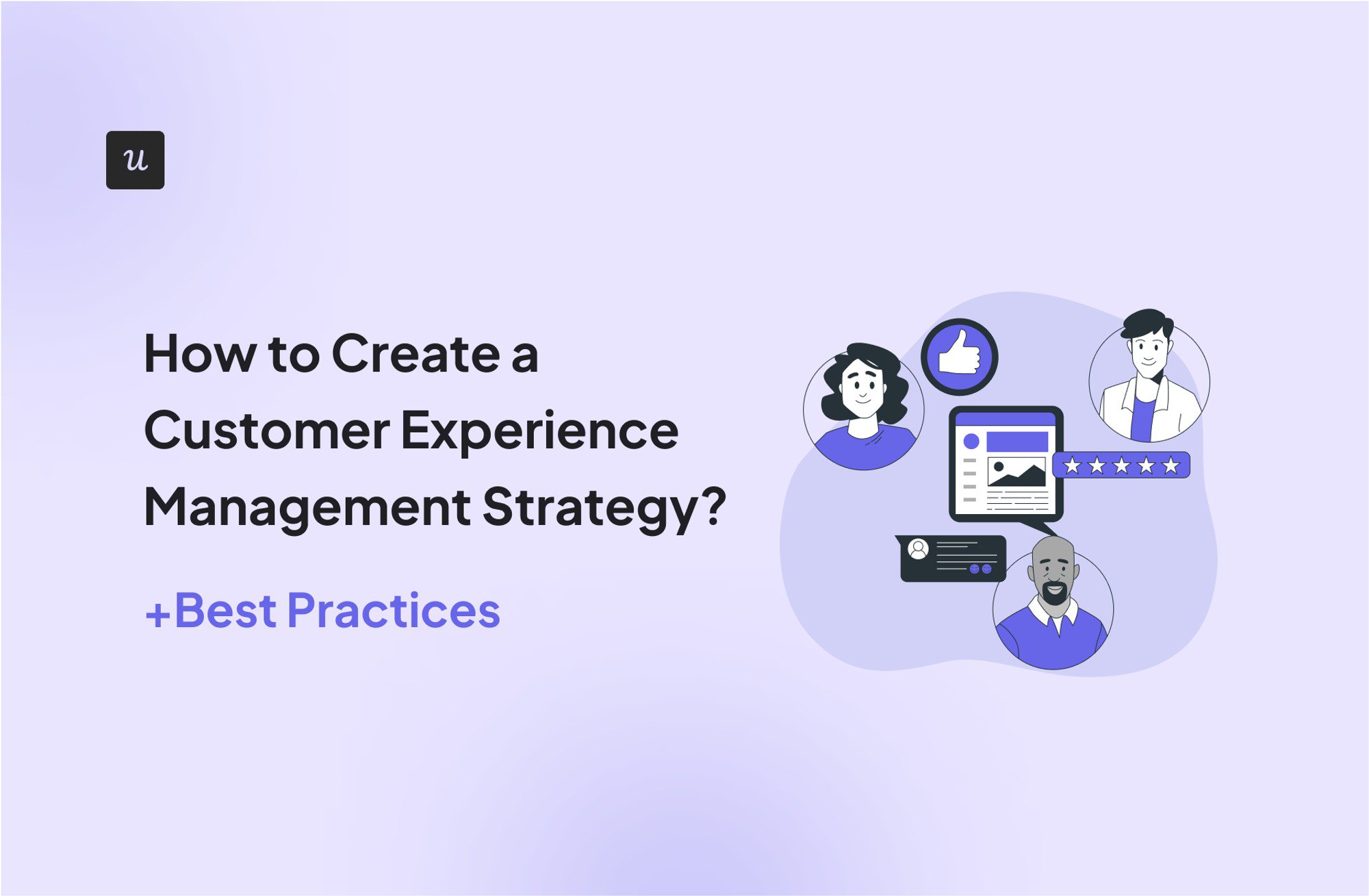
How to Create a Customer Experience Management Strategy? (+Best Practices)
What is a customer experience management strategy? Why is it important? How to create it?
These are some of the questions this article covers, so if you’re after the answers, you’re in the right place!
We also share best practices for product teams seeking to optimize their strategies and enhance customer engagement throughout their journey with the product.
Let’s dive right in!
Try Userpilot Now
See Why 1,000+ Teams Choose Userpilot

Overview on how to create a customer experience management strategy
- A customer experience management strategy is a plan whose aim is to enhance customer interactions throughout the customer lifecycle.
- The 4 P’s of customer experience are engaged and empowered people (your teams), efficient processes, customizable and user-friendly products, and places (websites, web, and mobile apps) that collectively contribute to exceptional service delivery.
- A robust customer experience strategy strengthens loyalty and improves retention, differentiates companies from competitors, and guides the development of products that align with customer preferences.
To create such a well-rounded strategy, follow the 7 steps:
- Conduct comprehensive customer research using various tools to uncover customer needs and pain points, and areas for improvement in the customer experience.
- Create detailed user personas based on research insights to focus your strategy and build a shared understanding of your target audience.
- Identify and analyze key customer interactions and touchpoints across different segments to understand how users engage with your product throughout their journey.
- Develop a customer journey map outlining key stages, touchpoints, user actions, feelings, and pain points to visualize the entire customer experience.
- Implement tactics to enhance customer experiences at various touchpoints.
- Evaluate the effectiveness of your customer experience strategies by tracking relevant metrics and conducting granular behavior analysis.
- Continuously refine your approach through experimentation and testing to maintain a positive impact as customer needs evolve.
Some customer experience best practices include:
- Run surveys throughout the customer journey to gather comprehensive feedback and insights on user satisfaction, ease of use, and product-market fit.
- Use robust customer experience management software to track user interactions, collect feedback, and engage customers across multiple channels.
- Benchmark your performance against industry standards and competitors to assess the effectiveness of your customer experience strategies and identify areas for improvement.
- Foster a customer-centric culture throughout your organization by prioritizing customer needs, empowering employees, promoting cross-functional collaboration, and committing to continuous improvement.
- Want to see how to implement the strategies in your product with Userpilot? Book the demo!
What is a customer experience management strategy?
A customer experience management (CXM) strategy is a plan designed to optimize customer interactions with a brand throughout their entire journey.
The goal?
To create positive, personalized experiences that drive customer satisfaction, loyalty, advocacy, and business performance.
What are the 4 P’s of customer experience?
The 4 P’s of customer experience are:
- People: engaged, motivated, well-trained, empowered to provide exceptional service and constantly seeking opportunities to enhance customer experience.
- Processes: streamlined, efficient, and customer-friendly processes driven by customer feedback at all stages of the customer journey.
- Products: reliable and highly customizable products that satisfy unique customer needs and exceed their expectations.
- Place: well-designed, easy-to-navigate, and inclusive online platforms and mobile apps providing a frictionless experience and ensuring seamless access to products and omnichannel support.
Why is a customer experience strategy important?
A robust customer experience management strategy offers multiple benefits. Let’s unpack 3 key ones.
Increases customer loyalty and retention
A well-executed customer experience strategy improves customer satisfaction with their brand interactions at every touchpoint.
Increased satisfaction often translates into higher customer loyalty: customers who have a positive experience are more likely to continue using the product.
Best part?
Loyal customers don’t just provide repeat business and generate a stable revenue stream. They also act as product advocates. By spreading good word of mouth about the product among their friends and colleagues, they drive product growth and reduce customer acquisition costs.
Results in a strong competitive advantage
In competitive sectors like SaaS, it’s difficult to compete on features – they are easy to copy.
A superior customer experience is much more difficult to emulate and can set you apart from your competitors. By consistently delivering positive experiences, you can differentiate yourself and attract customers who are looking not just for a product but a seamless and enjoyable journey.
This competitive edge helps businesses capture market share and build a strong brand reputation.
Develops valuable products that meet customer preferences
The customer feedback that you collect as a part of your customer experience strategy can help you better understand your customers’ needs and preferences.
If used to guide the product development process, these insights can help you build products that are better aligned with their expectations and deliver genuine value.
How to create a great customer experience management strategy?
With the background information covered, you’re ready to start creating a customer management strategy. We’ve broken the process into 7 steps.
1. Conduct customer research to understand their needs and pain points
The first step involves customer research. The aim? To understand all their pains and frustrations and identify unmet needs.
For best results, use a range of research tools:
- In-app and email surveys (e.g., Customer Effort Score surveys).
- Product analytics (to find friction in the customer journey).
- Interviews and focus groups (to gather qualitative data on how to improve the customer experience).
- Usability testing (to test if the product is intuitive to use and accessible to users with diverse needs).
- Competitor analysis (do they offer anything that you don’t? What problems do they solve that you don’t?).

2. Develop customer personas to guide your strategy
Next, use the research insights and your knowledge of the product to create user personas. This will give your strategy the necessary focus.
Make this a team exercise and involve stakeholders from across the organization to gain diverse insights and build a shared understanding of the target audience.
Focus on their:
- Role in the company (e.g., product manager).
- Jobs to be done (e.g., identify user needs).
- Company details (sector, size, maturity, goals).
- Pains or challenges (e.g., lack of technical skills).
- Team collaboration (key stakeholders).
- Gains from using the product (e.g., building in-app surveys and tracking user behavior without coding).

3. Identify important customer interactions and touchpoints
It’s time to zero in on how the users interact with the product at different touchpoints. You probably have a good idea already, but it’s always a good idea to validate your assumptions.
Start by segmenting your users based on their use cases. As each user persona has different goals, they use the product differently.
Next, track and analyze their interactions with the product along the customer journey, which is fairly easy in SaaS because most of them are digital.
Here are some ideas on how to do it:
- Use social media management and listening tools to track how users engage with your social content.
- Leverage the web to track engagement with your PPC ads, homepage, landing pages, and sign-up forms.
- Analyze in-app behavior with product analytics platforms to identify patterns.
- Study how users interact with the customer support team by analyzing support tickets, phone calls, and chats.

4. Map out the entire customer journey
Once you have the necessary customer data, it’s time for customer journey mapping.
First, outline the key customer journey stages. Typical stages for SaaS products are: Awareness, Consideration, Decision, Activation, Adoption, Retention, Expansion, Loyalty, and Advocacy.
Next, list the key touchpoints at each stage along with the user actions. For example, at the consideration stage, users often ‘take part in a live product demo‘.
For each touchpoint, list user feelings and pain points they experience and opportunities to alleviate them.
If you have multiple personas, map the customer journeys for all of them.
Final tip: using a customer journey map template from Canva or Miro will speed up the process considerably.

5. Implement tactics to improve customer experiences
Having identified the opportunities to improve customer experience across different touchpoints, let’s act on them.
First, prioritize them by scoring them according to pre-defined criteria, like urgency or importance. So that your initiatives are aligned with your organizational goals.
For example: If users complain about inadequate support materials, redesigning your resource center seems to be more urgent than setting up a referral scheme because it has an impact on existing customer satisfaction.

6. Analyze the performance of customer experience strategies
How do you know the implemented strategies work?
One way to check it is by tracking relevant metrics. For example, an increase in the user activation rate shows that the onboarding process is working, while a reduction in customer support tickets could indicate that the new self-service support resources are doing their job.
To gain more in-depth insights, analyze user behavior on a more granular level. For example, to see which parts of the onboarding flow need further improvement, you can conduct funnel analysis.

7. Continuously improve your strategy to increase customer satisfaction
Even if your strategies are performing well, their positive impact may decline as customer needs and preferences change.
But what if you pick up a negative trend, like declining engagement or account expansion?
Experiment with different strategies to bring the metrics back on track.
For example, you could run A/B and multivariate tests to find a more effective onboarding flow. In such tests, you enable 2 or more versions of the flow at the same time for users from the same sample and watch which performs better.

Best practices for executing a successful CXM strategy
Let’s wrap up with a few best practices for implementing a successful customer management experience strategy.
Create personalized experiences to exceed customer expectations
As mentioned, different user personas have different goals and use the product differently to achieve them. This should be reflected in the experiences you offer.
For example, your onboarding should help users discover the key features relevant to their use cases to reduce time to value and avoid distracting users with irrelevant features.
To do so, start the onboarding journey with a welcome survey to collect profiling information about new customers. And use the insights to trigger an interactive walkthrough or checklist that guides them to value along the most direct route.

Collect customer feedback at different stages of the journey
To gain an in-depth understanding of customer needs and their sentiment towards the product, collect and analyze customer feedback throughout the user journey.
Here are some survey types to consider:
- Onboarding survey – to inform improvements to the onboarding process.
- CSAT and NPS surveys – to track customer satisfaction and sentiment.
- CES surveys – to measure how easy it is to perform tasks or use features.
- PMF surveys – to ensure the product keeps satisfying customer needs.
- Churn survey – as a part of the cancellation flow.
You can find templates for all these survey types in the Userpilot’s template library.

Invest in robust customer experience management software
Speaking of Userpilot… a solid customer experience management tool offers product and customer success teams some serious advantages.
Such tools provide a unified platform from which you can track user interactions within your product and thanks to integrations with 3rd party analytics and customer relationship management tools, at different stages of the customer journey.
More importantly, they provide you with tools to engage customers to enhance their experience and help them achieve their goals.
For example, with Userpilot, you can create onboarding experiences and communicate with users through in-app messages. And use webhooks to create custom integrations with other tools, like email clients, for omnichannel engagement.

Benchmark your performance against your competitors
If you’re only starting to implement customer experience management strategies, it may be hard to assess how well they’re performing.
Fortunately, you can use industry benchmarks to see how your products stack against competitors.
For instance, Userpilot’s Product Metrics Benchmark Report looks into 6 metrics User Activation Rate, Time to Value (TTV), Month 1 Retention Rate, Core Feature Adoption Rate, Onboarding Checklist Completion Rate, and Net Promoter Score (NPS).
And to make any comparisons meaningful, it breaks the data down by vertical and acquisition strategy.

Create a customer-centric culture in your company
To design and implement a successful customer experience management strategy, your organization needs a customer-centric culture.
What does it involve?
- Prioritizing customer needs at all stages of the product lifecycle.
- Setting clear and customer-focused goals.
- Empowering employees with training and authority to make independent decisions.
- Fostering cross-functional collaboration to ensure everybody is pulling in the same direction.
- Committing to continuous improvement and ensuring satisfied customers remain the top priority.
Conclusion
A comprehensive customer experience management strategy can help you optimize interactions throughout the customer lifecycle. This translates into better customer satisfaction, stronger customer relationships, and consequently, better business performance.
If you’d like to learn more about Userpilot and how to use it to execute your customer experience management strategy, book the demo!








